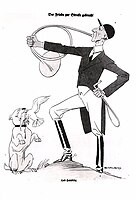Oskar Garvens

Oskar Theodor Garvens (20 November 1874 – 18 November 1951) was a German sculptor and caricaturist.
Born in Hanover in 1874,[1] and educated at the Academy of Fine Arts, Munich,[2] Garvens was a supporter of traditional schools of art and mocked cubism in particular.[3][4]
In 1911, Garvens married Margarete Unger, and they had two children, Klaus (born 1912 in Berlin) and Ursula (born 1914).[5]
As well as publishing work in the influential arts magazine Jugend,[6] during the 1920s Garvens became one of the leading illustrators for the satirical magazine Kladderadatsch, which identified with "militant conservatism" and was an early supporter of the Nazi Party.[7][8]
Garvens sometimes signed his work with a monogram of a small letter "o" inside a larger capital "G".[6]
Gallery
[edit]-
Statue in Stadtfriedhof, Hanover
-
"My wife and my young son", c. 1914
-
Caricature of Friedrich Ebert, 1919
-
"Combing her hair", 1927
-
"The Answer", 1927
-
"The Peace brought down", September 1939
Notes
[edit]- ^ a b "Oskar Garvens", Musée d'Orsay, accessed 7 July 2023
- ^ "Oskar Garvens", Netherlands Institute for Art History at rkd.nl, accessed 8 July 2023
- ^ "The Art of Caricature - Oskar Garvens (1874–1951) looks at cubism and naturalism" in New Statesman and Nation, Vol. 102 (1981), p. 17
- ^ Edward Lucie-Smith, The Art of Caricature (London: Orbis Publishing, 1981, ISBN 978-0856130700), p. 120
- ^ "Oskar Garvens", online-ofb.de, accessed 8 July 2023
- ^ a b Franz Goldstein, "Garvens, Oskar Theodor, Berlin, geb. Hannover 1874, gest. 1951; Bildhauer, Karikaturist, Zeichner, Mitarbeiter der „Jugend“" in Internationales Verzeichnis der Monogramme bildender Künstler seit 1850 (Walter de Gruyter GmbH, 2020), p. 285
- ^ Lasse Wichert, Personale Mythen des Nationalsozialismus: Die Gestaltung des Einzelnen in literarischen Entwürfen (Verlag Wilhelm Fink, 2018), pp. 327, 333
- ^ Klaus Haese, Wolfgang Schütte, Frau Republik geht pleite: Deutsche Karikaturen der zwanziger Jahre (Leipzig, 1989), pp. 114, 132






